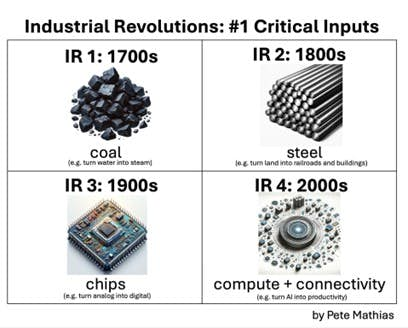Connectivity & Compute
The Engines of the Fourth Industrial Revolution

At the heart of every industrial revolution lies a critical element. A resource that propels society into a new age of innovation. What is the defining resource of our time? This blog will propose connectivity and compute as the focus of the next revolution.
THE FIRST THREE INDUSTRIAL REVOLUTIONS
First, let us look back at the prior three industrial revolutions (IRs).
Coal: The Steam Power Behind the First Industrial Revolution
The critical element of the First Industrial Revolution (1IR) in the 1700s was coal. Moving from manual labor to mechanization required coal to, for example, turn water into steam. Without coal, we would not have the steam engine that powered the factories, trains that crisscrossed continents, and steamships that connected the world, laying the foundation for modern industry and shaping the technological landscape of the future.
Steel: The Backbone of the Second Industrial Revolution
Steel was the essential enabler of the Second Industrial Revolution (2IR) in the 1800s. The move to mass production made steel indispensable for building infrastructure and machinery, thanks to its durability and scalability. Without steel, we would not have the monumental skyscrapers, bridges, and railways that are synonymous with the era’s progress.
Semiconductors: The Digital Catalyst of the Third Industrial Revolution
In the late 1900s, the Third Industrial Revolution (3IR) introduced a shift to digital production, making semiconductors critical for computing, telecom, and consumer electronics. We would not have the interconnected digital world that defines our current landscape without semiconductors.
Each of these materials—coal, steel, and semiconductors—has not only defined an era but has also laid the groundwork for the next. They underscore the profound impact that a single resource can have on the trajectory of human development, reminding us that we will not have progress, innovation, or the future we envision without recognizing and harnessing the defining resources of our time.
THE FOURTH INDUSTRIAL REVOLUTION
As the title of this blog indicates, I believe the defining resource of the next generation is clear:
Compute and Connectivity: The Engines of the Fourth Industrial Revolution
The dominant critical input of the Fourth Industrial Revolution (4IR) is not one but two twin resources: compute and connectivity. Open AI’s Sam Altman calls compute the “currency of the future.” It will be fundamental, as will be the other “c” – connectivity.
To understand the importance of compute and connectivity, think of it like building a spaceship. You need a powerful engine (compute) to propel you through the cosmos. But you also need a robust communication system (connectivity) to navigate the vast unknown. Without both, you’re stuck grounded.
Learn More About the U.S. Strategic Tech Fund
We are seeing strong interest in our U.S. Strategic Tech Fund. If you’d like to join us, we recommend securing a spot promptly.
Invest in technologies vital to U.S. national interests in a portfolio of ~15-20 venture investments made over ~12-18 months — diversified by stage, sector, geography, lead investor.
Max Accredited Investor Limit: 249

The Essential Frontier for Compute and Connectivity: The Edge
These two C’s are most obviously essential in one particular place: on the “edge” — or the places where data is generated. Amazon Web Services (AWS) defines edge well: “Edge computing is running workloads at the edge — that is, closer to devices and end users.” Intel explains how important compute and connectivity will be in proximity to users: “The edge is the next frontier of digital transformation, being further fueled by AI,” according to Pallavi Mahajan, Intel Corporate Vice President of Network and Edge Group Software.
Another way to understand edge” is to visualize use cases. Edge use cases are vas. For example:
- An automobile manufacturer optimizes efficiency and production across its global facilities through IoT and machine learning.
- A streaming service utilizes edge networking to manage high user traffic, ensuring seamless content delivery.
- A game developer employs cloud infrastructure to reduce online game latency, enhancing competitive fairness and player experience.
- A factory utilizes IoT devices to monitor machinery in real time.
- A hospital deploys wearable devices for patient monitoring to ensure immediate medical intervention.
- A farm uses sensors and drones for precision agriculture to track crop health and soil moisture levels.
All of these edges are frontiers for the Fourth Industrial Revolution that will require connectivity and compute, or where “data meets decisions.”
The Urgent Pace of Innovation: Building Infrastructure for Tomorrow, Today
These edge capabilities encompass a spectrum of technological domains, including cloud and edge computing, AI, 5G, IoT, and cybersecurity. All are integral to powering and securing the interconnected digital ecosystem of the 4IR.
But unlike past revolutions, we don’t have as much time to build that infrastructure. While the steel-built railroads took decades, we really only have days, weeks, months to keep up with the compute-voracious apps from AI to AR/VR. Without advancements in compute and connectivity, we will have only a partial revolution. Manufacturing, for example, will be left further behind.
Leveraging 5G, WiFi6, and Satellites: The Connective Tissue of 4IR
Turning data into productivity requires secure, dense networks and computational power. The good news: we have the pieces: 5G, WiFi6, satellite constellations, for example. But we will need more investment.
The Economic Impact of Industry 4.0: A Trillion Dollar Opportunity
This is a massive market. McKinsey estimates that by 2025, Industry 4.0 will reach $3.7 trillion. The analysis predicts that companies embracing Industry 4.0 technologies could see a 122% cash flow increase by 2025, while non-adopters face a 23% decrease.
STARTUP INNOVATION: BUILDING THE FUTURE OF CONNECTIVITY AND COMPUTE
With favorable economics and now tech breakthrough use cases in generative AI and novel AR/VR consumer rollouts, we are about to see a torrent of disruption that unlocks productivity. Startups are preparing to build that future by building connectivity and compute solutions. Here are just a few:

Alkira provides a cloud networking solution to seamlessly connect different networks, enhancing multi-cloud network provisioning and visibility.

Armada Logistics has developed a connected solution to track shipments in transit, using IoT to offer real-time updates and deep learning for delivery impact analysis.

Celonis provides cloud-based process mining and execution management software to analyze business processes in real time and improve operational efficiency with predictive analytics.

Crusoe has created cloud-based AI solutions to reduce natural gas flaring in the oil and gas industry by converting waste gas into energy for advanced computing systems.

Edge Impulse offers AI and cloud services to build embedded machine learning applications, supporting industries from consumer devices to enterprise solutions.

EnCharge delivers AI computation stack solutions with customizable hardware and software to meet diverse application needs.

Vapor works with big internet and cable companies to create super-fast internet services right near businesses. This makes it easier and faster for them to use online services without having to manage a bunch of computer servers on their own.
REVOLUTIONIZING CONNECTIVITY AND COMPUTE AT THE EDGE

In the Fourth Industrial Revolution, the emphasis on compute and connectivity is transforming our technological framework. Edgescale AI’s CEO, Brian Mengwasser, stresses the revolution’s core:
“We know that GDP gains in the AI era come from inference which consumes huge volumes of operational data. Demand for inference, the operational data it requires, IoT devices that generate that data are all growing exponentially. Exponential data requires suitable high density networks. True to its name, this revolution requires us to entirely rethink and reinvent how we scale compute and handle such volumes.”
See video policy below.
“Scale means considering now mass production of entire clouds, high-density networks that allow for millions of sensors in a hospital, software that allows a robot to talk to any network on the planet at once, and distribution of AI to where the data is generated and inference is made.”
For more, watch my interview with Brian here
THE INFRASTRUCTURE OF INNOVATION: BUILDING THE FUTURE TODAY
As vibrant as it may be, the Fourth Industrial Revolution will not be possible unless we invest into the backbone of these use cases. Just as new infrastructure — railways, foundries, and power plants —- was needed to reach a thriving second Industrial Revolution, our infrastructure needs an upgrade to realize 4IR. Wooden carriages and brick roads of the past won’t cut it.
Learn More About the U.S. Strategic Tech Fund
We are seeing strong interest in our U.S. Strategic Tech Fund. If you’d like to join us, we recommend securing a spot promptly.
Invest in technologies vital to U.S. national interests in a portfolio of ~15-20 venture investments made over ~12-18 months — diversified by stage, sector, geography, lead investor.
Max Accredited Investor Limit: 249